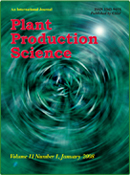Volume 8, Issue 3
Displaying 1-17 of 17 articles from this issue
- |<
- <
- 1
- >
- >|
Irrigated Rice-Based Systems
-
2005 Volume 8 Issue 3 Pages 221-230
Published: 2005
Released on J-STAGE: September 22, 2005
Download PDF (529K) -
2005 Volume 8 Issue 3 Pages 231-241
Published: 2005
Released on J-STAGE: September 22, 2005
Download PDF (545K) -
2005 Volume 8 Issue 3 Pages 242-258
Published: 2005
Released on J-STAGE: September 22, 2005
Download PDF (571K)
Future of Asian Cropping Systems
-
2005 Volume 8 Issue 3 Pages 259-274
Published: 2005
Released on J-STAGE: September 22, 2005
Download PDF (620K) -
2005 Volume 8 Issue 3 Pages 275-287
Published: 2005
Released on J-STAGE: September 22, 2005
Download PDF (574K) -
2005 Volume 8 Issue 3 Pages 288-297
Published: 2005
Released on J-STAGE: September 22, 2005
Download PDF (509K)
New Pathways for Delivery in Asian Countries
-
2005 Volume 8 Issue 3 Pages 298-307
Published: 2005
Released on J-STAGE: September 22, 2005
Download PDF (497K) -
2005 Volume 8 Issue 3 Pages 308-319
Published: 2005
Released on J-STAGE: September 22, 2005
Download PDF (499K)
Improving the Quality of Food in Asia
-
2005 Volume 8 Issue 3 Pages 320-325
Published: 2005
Released on J-STAGE: September 22, 2005
Download PDF (459K) -
2005 Volume 8 Issue 3 Pages 326-329
Published: 2005
Released on J-STAGE: September 22, 2005
Download PDF (636K) -
2005 Volume 8 Issue 3 Pages 330-333
Published: 2005
Released on J-STAGE: September 22, 2005
Download PDF (541K) -
2005 Volume 8 Issue 3 Pages 334-337
Published: 2005
Released on J-STAGE: September 22, 2005
Download PDF (459K)
Diversified Cropping Systems for Asia
-
2005 Volume 8 Issue 3 Pages 338-341
Published: 2005
Released on J-STAGE: September 22, 2005
Download PDF (438K) -
2005 Volume 8 Issue 3 Pages 342-344
Published: 2005
Released on J-STAGE: September 22, 2005
Download PDF (461K) -
2005 Volume 8 Issue 3 Pages 345-348
Published: 2005
Released on J-STAGE: September 22, 2005
Download PDF (478K) -
2005 Volume 8 Issue 3 Pages 349-353
Published: 2005
Released on J-STAGE: September 22, 2005
Download PDF (458K) -
2005 Volume 8 Issue 3 Pages 354-357
Published: 2005
Released on J-STAGE: September 22, 2005
Download PDF (514K)
- |<
- <
- 1
- >
- >|
